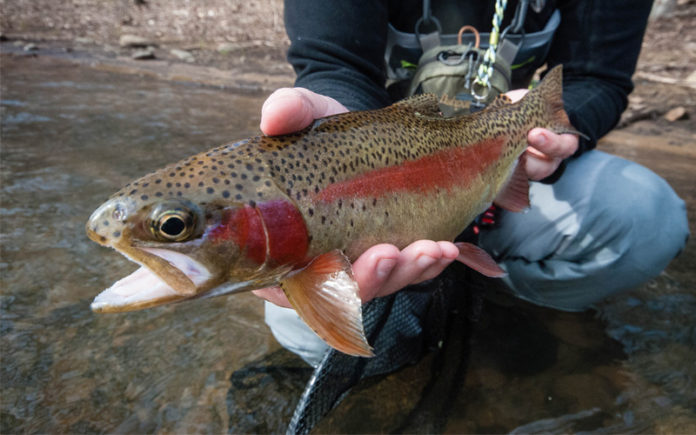By Matt Reilly
Photos by Mat Reilly
If you were to poll a group of anglers on their favorite times of year to fish, winter would likely fall at the bottom of the list for most. The month of February, in particular, can be a hard one to love. High water, sub-freezing days, and wild bouts of wind are all common occurrences during the second month of the year in the Old Dominion—but so is great trout fishing.
By mid-winter, DWR is in the middle of its trout stocking season, but more importantly, fishing pressure is at an all-year low, the trout streams are usually running healthy and full, and in streams with populations of wild rainbow trout, the fish are feeding well in preparation for spawning in late-winter and early-spring.
The South Fork of the Holston River in southwest Virginia’s Mountain Empire is one of the state’s greatest wild rainbow trout streams, and a great wintertime fishing destination. The river rises at the confluence of several smaller mountain streams in the Smyth County community of Sugar Grove, and flows 40 miles through the Jefferson National Forest and private land adjacent to Mount Rogers on its way to South Holston Lake. For most of that journey, the river flows over limestone geology pocked with countless springs that keep the stream’s temperature fluctuations slightly more controlled than other surrounding waters, meaning that it holds the coldest water in the summertime and the warmest water in the wintertime.
Groundwater influence, along with the region’s physical elevation and the protection that surrounding National Forest land provides to its headwaters, maintains exceptional year-round habitat for trout in the South Fork, allowing the stream’s population to reproduce naturally throughout its entire length.
Public water abounds on the South Fork, in the form of both stocked trout water and special regulation areas.

The uppermost reach of public water is a 4 ½-mile-long stretch of river that extends from the upper boundary of the Jefferson National Forest, through what is known as “the gorge,” and ends about 500 feet above the concrete spillover dam at the Buller Fish Cultural Station. Here anglers are limited to single-hooked artificial lures, and a creel of two fish per day with a minimum length of 16 inches.
Between the dam at Buller and the special regulations area, DWR maintains a short, 500-foot long stretch of put-and-take water.
The mile of water below the dam, ending at the lower boundary of the fish hatchery property, is managed as a catch-and-release area, where only single-hook artificial lures are legal.
Downriver from the hatchery property, there are three more put-and-take sections ranging from a mile to 2 miles in length—one in vicinity of Thomas Bridge, one reaching from Red Stone Road downstream to Hiler Bridge, and another spanning the distance between the Chilhowie Riverside School and Saint Clair’s Bottom.
All of the stocked sections of the South Fork are Category A stocking locations, meaning they receive eight stockings between October 1 and June 15. However, due to the excellent year-round trout habitat, anglers fishing these sections are perhaps more likely to catch a wild trout than a stocked trout.
Thanks in large part to the limestone geology the stream runs through, the South Fork is rich in water chemistry and has a great diversity of fish food.
In the winter, fly anglers have the relatively unique opportunity to fish dry flies in sporadic afternoon hatches of blue quill and blue-winged olive mayflies. Stoneflies, midges, and mayfly nymphs are prominent subsurface insects that will surely fool a feisty wild rainbow.
The higher (on average) flows of winter also provide a strong opportunity for anglers looking to target the South Fork’s brown trout population, which, though vastly overshadowed by the rainbow trout in number, is not insignificant. Crayfish, sculpin, and minnow imitations are a good place to start.
As a fly angler, my tackle of choice on the South Fork is a four-weight fly rod with a floating line, unless I’m targeting larger trout with streamers and a six-weight. Spin anglers would do well with a light action rod and a selection of in-line spinners and small jerkbaits, provided the treble hooks are traded out for single hooks where necessary.
Though the average fish in the South Fork is a rainbow trout in the six- to 10-inch range, plenty of larger fish fin the creek. In fact, one of Virginia’s state record brown trout—a 14-lb 12-oz fish—was pulled from the South Fork. So it’s worth taking the possibility of hooking into a good-sized fish into consideration when choosing tackle.
Late-winter is a vastly overlooked window of opportunity for trout anglers in the Commonwealth. Consider a trip to the Mountain Empire to kick cabin fever and experience one of the state’s richest trout fisheries.
Matt Reilly is a full-time freelance writer, outdoor columnist, and fly fishing guide based in southwest Virginia.
Credit: Source link































